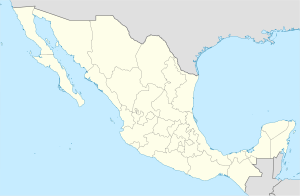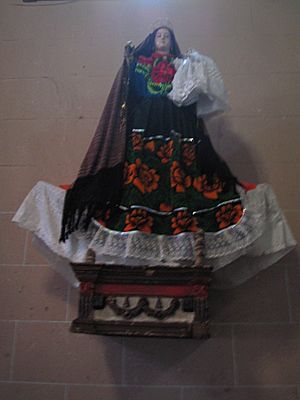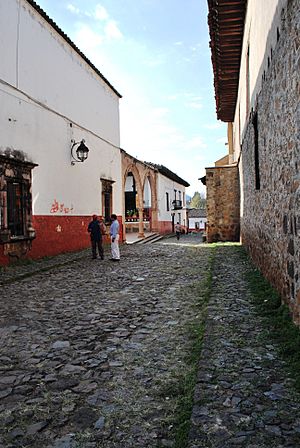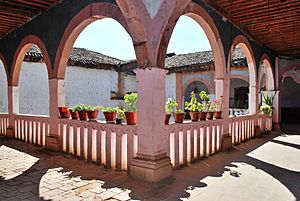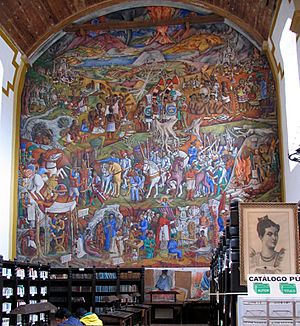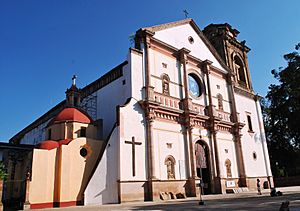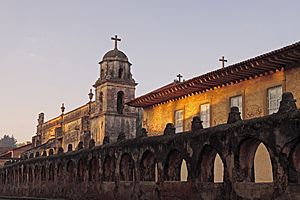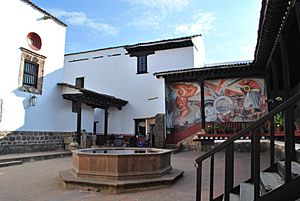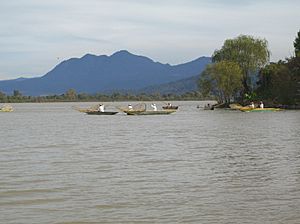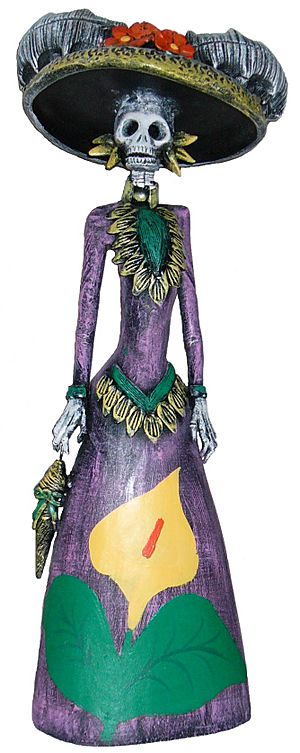Pátzcuaro facts for kids
Quick facts for kids
Pátzcuaro
|
|
|---|---|
|
Town & Municipality
|
|
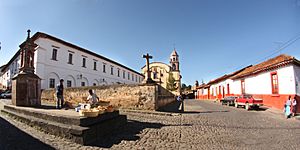 |
|
| Country | |
| State | Michoacán |
| Founded | 1320? |
| Municipal Status | 1839 |
| Area | |
| • Municipality | 435.96 km2 (168.33 sq mi) |
| Elevation
(of seat)
|
2,140 m (7,020 ft) |
| Population
(2005) Municipality
|
|
| • Municipality | 79,868 |
| • Seat | 51,124 |
| Time zone | UTC-6 (Central (US Central)) |
| • Summer (DST) | UTC-5 (Central) |
| Postal code (of seat) |
61600
|
| Area code(s) | 434 |
| Website | Official site: http://www.patzcuaro.gob.mx/ |
Pátzcuaro (Spanish: [ˈpatskwaɾo]) is a cool city and municipality in the state of Michoacán, Mexico. It was founded a long time ago, around the 1320s. First, it was the capital of the Purépecha Empire, and later it became their special ceremonial center.
After the Spanish arrived, a kind man named Vasco de Quiroga wanted Pátzcuaro to be the main city of the Michoacán province. But after he passed away, the capital moved to a nearby city called Valladolid (which is now Morelia). Pátzcuaro has kept its old-world charm and native culture ever since. It's even been named one of Mexico's 111 "Magical Towns" by the government! Pátzcuaro and the lake area around it are super famous for their Day of the Dead celebrations.
The name "Pátzcuaro" might mean a few different things. It could mean "place dyed in black," "place of foundations," or even "place of bullrushes." Some people also think it means "happy place" or "seat of temples." In 1553, Pátzcuaro got its own special coat of arms from Charles V of Spain.
Contents
Pátzcuaro's Past: A Look at History
The only old story we have about how Pátzcuaro began comes from a book called Relación de Michoacán, written around 1539-1541. It says that two leaders, Páracume and Vápeani, came to this area with their tribe, the Chichimecas. They started building their temples by placing four big rocks together. We don't have an exact date, but since these leaders died in 1360, people guess Pátzcuaro was founded around 1324.
Around that time, three different groups lived near Lake Pátzcuaro and often fought. The Purépecha Empire started when Tariácuri, a strong leader, became the "caltzontzin" (emperor) and took over his neighbors. Pátzcuaro was the first capital of the Purépecha. The kingdom was split into three main areas: Ihuatzio, Tzintzuntzan, and Pátzcuaro. Later, Tzintzuntzan became the new capital, and Pátzcuaro became a special place for ceremonies and a getaway for important people.
When the Spanish arrived in Michoacán, many people hid in Pátzcuaro. They even built forts in a neighborhood still called "Barrio Fuerte" (Fort Neighborhood). There was fighting between the Purépecha and the Spanish. The Purépecha emperor, Tanganxoan II, met with a Spanish leader, Cristóbal de Olid. Olid greeted the emperor, but then asked him to kneel in front of everyone. A chapel called "El Humilladero" (The Place of Humiliation) was built there later.
In 1526, Nuño de Guzmán came to rule for Spain and was very harsh to the Purépecha. This led to the sad end of Tanganxoan II, the last Purépecha emperor. After this, many people left Pátzcuaro and went to the mountains. Then, Vasco de Quiroga arrived. He sent Nuño de Guzmán away and took his land. Nuño was later sent back to Spain for his bad actions.
In 1538, the Spanish officially settled in Pátzcuaro. Vasco de Quiroga became the first bishop and made Pátzcuaro the capital of the new Spanish province. In the 1540s, Vasco de Quiroga convinced many native people to return and brought in Spanish families. Because of this, he is seen as the founder of modern Pátzcuaro. He even renamed the city "City of Michoacán," which was made official in 1553. Pátzcuaro's current coat of arms was also given then.
The main church was built over an old temple. Vasco de Quiroga wanted to build a huge cathedral with five sections, but the Spanish king said no. Only one section was built, and it's still there today. Pátzcuaro was the biggest city in the province for about ten years after Vasco de Quiroga died. But in 1575, the capital moved to Valladolid (now Morelia).
Pátzcuaro stayed important for trade and religion in the Lake Pátzcuaro area. During the Mexican War of Independence, Pátzcuaro was attacked many times. A brave woman named Gertrudis Bocanegra was shot in the main square in 1817 for helping the rebels. After Mexico became independent, Pátzcuaro became the center of its own municipality in 1831.
During the Reform War in 1867, Pátzcuaro supported the Conservatives. The city was then attacked by General Régules, who took control after a big fight. During the time of Porfirio Díaz, just before the Mexican Revolution, rich landowners controlled a lot of the land around Pátzcuaro. This made many people want to join the rebels. The town was important for rebels trying to take the Michoacán capital.
Later, when Lázaro Cárdenas was president (1934–40), Pátzcuaro became a popular place for tourists. They built new things to help tourism, created public monuments, and worked to keep the town's old look.
Exploring Pátzcuaro Town
Since the Mexican Revolution, Pátzcuaro has worked hard to keep its traditional look. Unlike bigger cities, houses here are often made of adobe or wood with tiled roofs. The streets in the center are made of cobblestones. The town is full of shops and sellers offering many colorful crafts. Pátzcuaro is a market hub, where smaller villages bring their special crafts like copper items, black pottery, and musical instruments.
Local foods include tamales (like corn cakes) or uchepos (a type of tamal), fish, tarasca soup, red pozole, and atole (a warm corn drink). You can also find trout dishes and cold corn-based drinks. Many homes in Pátzcuaro have courtyards and balconies full of flowering plants. People share tips and even cross-breed new flowers! The most common flower is the begonia, which blooms best from July to September. Other popular plants include geraniums, mallows, bougainvilleas, tiger lilies, marigolds, and roses.
The town's main center is called the Plaza Vasco de Quiroga or the Plaza Grande. It's a very large plaza for the size of the town. In 1964, a fountain with a bronze statue of Bishop Vasco de Quiroga was placed in the middle. This statue was made by artist Francisco Zúñiga from Costa Rica. The Plaza is surrounded by old ash trees and beautiful colonial buildings. Unlike most Mexican towns, the main church isn't right on this plaza. You'll find crafts everywhere, but especially in the Plaza. Shops here sell carved wooden statues, colorful textiles, pottery, copper items, and more.
Right on the main plaza is the Palace of Huitziméngari. This building, like many others, is made of adobe with a clay tile roof. It belonged to Antonio de Huitziméngari, the son of the last Purépecha ruler. He was also the godson of the first Spanish viceroy. The palace has two floors, a simple front, and a courtyard with round arches and lots of flowers. On the top floor, there's a statue of a dog. This is a nod to Huitziméngari's name, which in Purépecha stories referred to a dog that helped the Lord of Paradise. You can see dog designs on some of the doors inside too.
One block north of the Vasco Plaza is the Plaza Gertrudis Bocanegra, also known as the Plaza Chica (Small Plaza). The market near here sells woolen goods, kitchen tools, pottery, and straw items. Fridays are market days, and the walkways fill with stalls from different villages. During big holidays like Day of the Dead, this market can even spread to the other plazas. One building next to this plaza is the old Temple of San Agustin, built in the 1500s. Today, it's the Gertrudis Bocanegra Library. This library has a famous mural painted by Juan O'Gorman that shows the history of Michoacán.
Two blocks east of the Plaza Chica is the most important church in Pátzcuaro, the Basilica of Nuestra Señora de la Salud (Our Lady of Health). Vasco de Quiroga built this church over an old native ceremonial site to be the main cathedral for Michoacán. His original plan was huge, but only one section was built. The church was the Cathedral until 1850, when that role moved to Morelia. In 1924, it became a basilica. The outside has been changed over time and now looks Neoclassical. Inside, the ceiling looks like a dome but is actually flat. The special image here is the Virgin of the Immaculate Conception, also called "Our Lady of Health." It was made in the 1500s from corn-stalk paste and honey. Vasco de Quiroga's remains are buried here. People visit this basilica every day, especially on the eighth day of each month, to honor the region's patroness.
The Museo de Artes e Industrias Populares (Museum of Popular Arts and Industries) is just south of the Basilica. This building was first built in the 1500s by Vasco de Quiroga as the College of San Nicolás. It was meant to train young men for the church and teach native youth to read and write. After the college moved in 1580, the building became the College of Santa Catarina, a primary school. Today, it has one of the biggest collections of lacquered items, models, and other crafts.
The Temple Sagrario started being built in 1693 and finished exactly 200 years later. Because of this, it has many different building styles and decorations. The inside is Neoclassical, but the wooden floors are from the original building. It has a fancy Churrigueresque altar. On the west wall, there's a small chapel dedicated to the Virgin of Dolores with a Baroque altarpiece. These are the only ones of their kind left in Pátzcuaro. Since 1924, the building has been the Sanctuary of Nuestra Señora de la Salud.
The Casa de los Once Patios (House of Eleven Courtyards) was built in 1742 for Dominican nuns. They bought more houses next door, so the complex once had eleven courtyards, but now it has five. In the oldest part, there's a fountain and a Baroque doorway leading to a room that had a bathtub with hot and cold water – a rare luxury back then! In the 1960s, the complex was fixed up. Now, it's a place for workshops and shops where local crafts are made and sold, like shawls and lacquered items. Behind this house is the Pila de San Miguel, a water source. Legend says the devil used to bother women getting water here. To scare him away, Vasco de Quiroga put an image of the Archangel Michael there.
The Church of San Ignacio de Loyola, also known as the Temple of the Company of Jesus, is an important church. It has a simple but beautiful Baroque front. Inside, you'll find valuable religious paintings, including a series of angels and wooden artworks. One of these is a colorful panel about Saint Ignatius of Loyola. Vasco de Quiroga's remains were kept here before they were moved to the Basilica. The church complex has a large courtyard and a "punished" clock high up in a tower. It's called "punished" because it doesn't chime at noon. Some say the clock was sent from Spain because the king didn't like the hour it marked. Another story says a young woman was hurt by the clock when it was about to chime noon. In the 1500s, a fire damaged the complex, but it was rebuilt to how it looks today. This temple and the building next door were home to the Jesuits, who came to Pátzcuaro because they were known for their great education. The building next door is now the Casa de Cultura (House of Culture).
The Chapel del Humilladero was built by Vasco de Quiroga in 1553. It's on the spot where the last Purépecha emperor, Tanganxoan II, was asked to show respect to the Spanish. That's why it's called "The Place of Humiliation." The crucifix in this chapel was carved from a single block of stone. It's said Vasco de Quiroga had it started in 1553, but it wasn't finished until 1628.
Lake Pátzcuaro: A Natural Wonder
Pátzcuaro is located on the southern edge of Lake Pátzcuaro. This lake is still very important for the town's economy and culture. There are several islands in the lake. The most famous is Janitzio, which means "corn hair." You can spot it by the huge 40-meter statue of José María Morelos y Pavón on top of the hill. Inside the statue, there are murals about this Mexican hero's life.
There are four other islands in the lake. La Pacanda is in the center and has a small pond with carp and ducks. Yuneén Island is also near the center, and its name means "half moon." It's known for its plants, traditional houses, and cabins for visitors. Urandenes is closer to Pátzcuaro and has three islands surrounded by canals. White fish used to be raised here. The famous pez blanco (whitefish) that attracted tourists are no longer fished because the lake has become polluted. However, on special occasions, you can still see the famous butterfly nets displayed in canoes on the water. Tecuena is the smallest island, and its name means "good honey." Boats at the Pátzcuaro docks can take you to these islands.
Until 2007, only Pátzcuaro had a water treatment plant. Smaller communities used to send their wastewater directly into the lake, causing serious pollution. The pollution was mostly from chemicals, trash, wastewater, and dirt during the rainy season. Now, the Michoacán state government and environmental agencies are working to clean up Lake Pátzcuaro. The plan is to fix existing water treatment plants and build two more. It also includes planting more trees around the lake, building landfills, and creating barriers to stop pollution from reaching the lake's streams.
Day of the Dead: A Special Celebration
Pátzcuaro and the lake area are famous for their amazing Day of the Dead celebrations in Mexico. Markets selling Day of the Dead items are everywhere in Michoacán, but the best ones are in Pátzcuaro's main plaza. This is where a big craft competition is held. Day of the Dead is celebrated very strongly in the towns and villages around Lake Pátzcuaro.
People prepare by cleaning and fixing up local cemeteries and making beautiful arches of flowers for church gates. These arches are made with a flower called cempasúchil, also known as the Mexican marigold. Early on November 1st, there's a "velación de los angelitos" (wake for the little angels) to honor children who have passed away in the last year. This usually happens in the local cemeteries. On this day, there's also an event called "teruscan," where children run around town "stealing" corn, squash, and chayotes from neighbors' roofs. The "stolen" food is then cooked at the community center to feed everyone.
The celebrations continue until midnight on November 2nd, which starts the "velación de los difuntos" (wake for the deceased). Again, towns gather in local cemeteries. This time, men stay outside. Women and children go inside to place offerings of flowers and food, often on embroidered napkins. Then, prayers and chants are said. That's why Day of the Dead is often called Night of the Dead in Pátzcuaro. When daylight comes, food is collected for the local priest, and most people go to mass.
A fun event in Pátzcuaro and other Michoacán towns is the Festival Cultural de la Muerte (Cultural Festival of Death). Since 1993, this festival has shown paintings, photos, films, dance, crafts, and altars made for this day. Canoeing competitions on the lake are popular, as are "torneos de calaveras" (tournaments of skulls). These are funny poetry contests about death with a dark humor twist. This festival runs from October 27th to November 2nd.
Other traditional events include a concert at the Basilica of Pátzcuaro and a play called "Don Juan Tenorio" in Erongarícuaro. Both happen at 9 pm on November 1st. Another cool event is the "Juego Prehispanico de Pelota Encendida" (Pre-Hispanic Lighted Ball Game). At 7 pm on November 1st, in the village of Tzintzuntzan, the game is played in the old ball court, Las Yácatas, with a ball set on fire! It's also played in the village's main square.
There's a legend about Day of the Dead here about two Purépecha nobles, Princess Mintzita and Prince Itzihuapa. They were in love, but couldn't be together partly because the Spanish arrived. Princess Mintzita offered the Spanish a treasure hidden at the bottom of Lake Pátzcuaro to free her father. Itzihuapa offered to get it himself, but when he did, he was captured by 20 ghosts guarding the treasure, becoming the 21st guardian. This broke Mintzita's heart. However, this happened on the night these guardian ghosts come back to life for one night, and the two lovers got to spend time together until daylight.
Pátzcuaro Municipality
The town of Pátzcuaro is the main center for 104 other communities. The total population is about 79,868 people, and the area covers 435.96 square kilometers. In 2005, almost 4,000 people in the municipality spoke an indigenous language, Purépecha. The municipality shares borders with Tzintzuntzan, Huiramba, Salvador Escalante, Tingambato, and Erongarícuaro.
The municipality covers most of the Pátzcuaro lake area, which is part of the Trans-Mexican Volcanic Belt. It's surrounded by mountains like Cerro el Blanco and Cerro del Estribo. Almost all the water in Lake Pátzcuaro comes from a stream called El Chorrito and many freshwater springs. The weather is mild, with rain in the summer. Temperatures during the year range from a low of 1°C to a high of 30°C. The municipality is mostly covered in forests with pine, oak, and cedar trees. Most animals are small mammals and fish found in the lake.
Farming here mainly involves growing corn, wheat, beans, lentils, and tomatoes. People also raise animals like cattle, pigs, sheep, donkeys, horses, and chickens. Most industries here are about processing food and making crafts like furniture, textiles, jewelry, and religious figures. Most businesses serve tourists and meet the basic needs of local people. Fishing is still done in the lake. Tourism focuses on sites in Pátzcuaro town and nearby old sites like Ihuatzio and Tzintzuntzan. Fun sports like mountain biking and paragliding have also been introduced.
Famous People from Pátzcuaro
- Gonzalo Pineda (born 1982), head coach of Atlanta United
See also
 In Spanish: Pátzcuaro para niños
In Spanish: Pátzcuaro para niños


